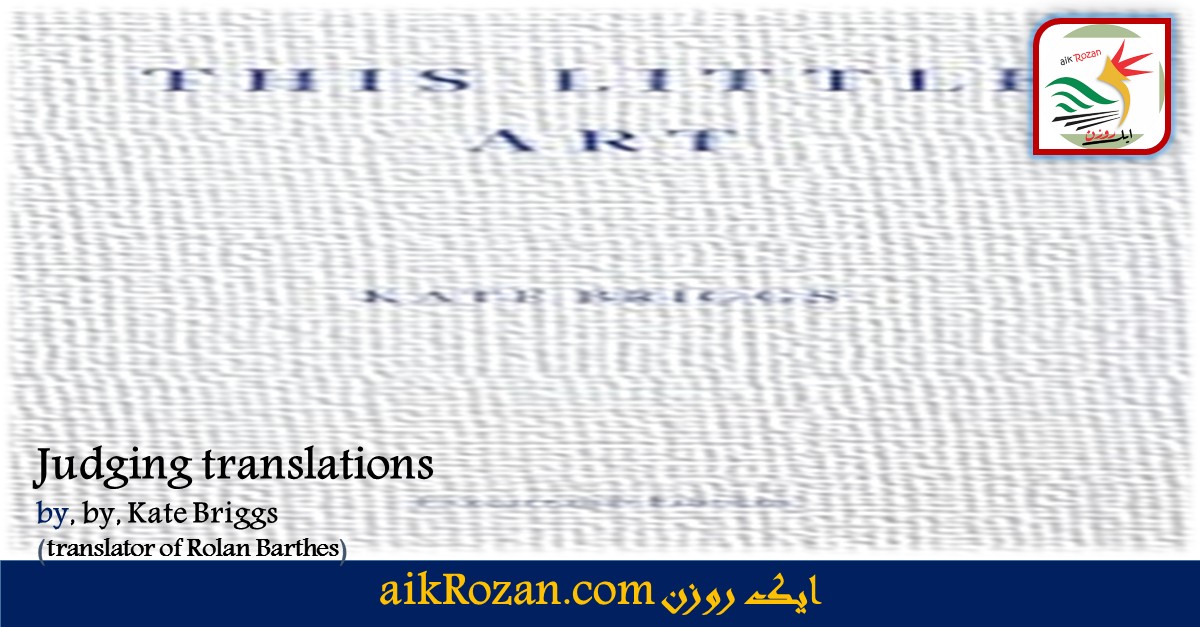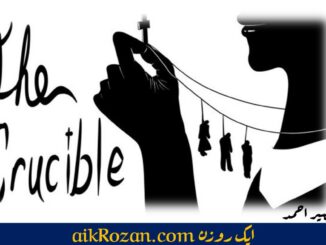
Judging translations
by, Kate Briggs
Look to the whole, the translator asked.
The line comes from Helen Lowe-Porter’s correspondence, and can be read as an early plea (from a letter to her publisher Alfred A. Knopf, dated 11 November 1943) against the kind of translation review which proceeds by finding and scrutinizing the apparent lapse, the moments of inattention, the local mistake or infelicity—which might always be of the order of a conscious decision on the translator’s part—and making these stand in for the quality of the full translation.
Michelle Woods discusses this very common form of translation-evaluation in the section titled “Gotcha!” of her account of Kafka’s English-language translators and translations. The expression comes from the translator Mark Harman, whose 1998 translation of Kafka’s The Castle was widely reviewed and discussed. In this kind of review, as Woods writes, “reviewers often hone in on perceived ‘mistakes’ in order to justify their own taste preferences and to present their own legitimacy as experts in judging a translation. Rarely glimpsed is a consideration of the translator, or where translation fits into their career and their background. . . and what the nature of their contribution should be.”
Looking to the whole is a call to consider the way the thing is working and reading altogether, the way its many parts work in relation to one another, and the larger ways in which the translation relates to the circumstances and motivations for making it (a call that, as Woods points out, Lawrence Venuti makes repeatedly throughout his work).
I would agree: it is unhelpful and unrealistic to think that a translation could fail as the result of a single or sample of local mistakes. For one thing, as Pye also points out, there is clearly a great deal more to making—to writing, to translation (to childcare?)—than not “spoiling the job.” According to Pye, a more productive set of criteria for evaluating the quality of workmanship—more productive than the commonly used “good” and “bad,” “precise” and “rough” would be “soundness” and “comeliness.” Soundness, he writes, implies “the ability to transmit and resist forces,” while comeliness “the ability to give the aesthetic expression which the designer [standing in here for the first writer] intended.” Or, indeed, “to add to it.” He goes on: “in some cases precision is necessary to soundness, but in many others it is not, and rough workmanship will do the job just as well. In some cases precision is necessary to the intended aesthetic expression but in others it is not and, on the contrary, rough workmanship is essential to it.” Not good or bad, then, nor precise or rough, not smooth or awkward, but sound or comely.
“I think we owe translators, and perhaps also ourselves, some recognition of what it might have meant to have handled every single word (space and punctuation mark) of the writing-to-be-translated.”
Soundness: the idea being that you should be able to use the thing made, to read it, to write on it, to drop it, to push at bits of it, to cite others, to set it to work and to activate it in all these ways in the context of your own life—and still it would hold. Comeliness: pleasing in its features and its proportions.
I’m not sure how much work these new criteria could be made to do in the evaluation of translations. But I like them (I offer them here as possibilities to think on).
*
It is unhelpful to presume that a translation could fail as the result of a single or sample of local mistakes: gotcha! Thinking that it might is the mindset of the reviewers gamely offering their own corrections for the local scrutinized part.
But it is also—is it not?—the mindset of the translator, with her constant attentiveness, the very close form of her attention, her overall care. Or, to put the point another way, I think we owe translators, and perhaps also ourselves as readers of translations, not gratitude, but rather some intellectual recognition of the fact that her work pertains not just to this or that part picked out for late scrutiny by the reader or the reviewer, but to every single one of the small parts forming the whole. In other words: I think we owe translators, and perhaps also ourselves, some recognition of what it might have meant to have handled every single word (space and punctuation mark) of the writing-to-be-translated, to have taken a decision in relation to its every single word (space and punctuation mark), and indeed to have written every single one of its parts, where those parts are recognized to be the combinatory elements of its larger discursive structures (paragraphs, chapters, the whole thing), and where each and every one of its parts is another way of saying each and every one of its questions, every single one of the questions, of every kind of order, that the project of translating causes to emerge (answers formulated in the form of a new sentence; then, a great sequence of new sentences), which might in turn be another way of saying each and every one of its risks. Risks which are if not quite at every moment (since early decisions can of course be considered and considered and edited and reconsidered) then certainly in every detail real.
*
For example: do we write translations or do we make them? Or, indeed, do we do them? It’s a question that setting the practice of translation in relation to tables, to craft and workmanship was always going to raise. It also pertains to one of my own local translation decisions. A decision that wasn’t made spontaneously, not off-the-cuff or in the moment, but reflected upon and discussed with others and reconsidered—and then upheld nonetheless. The decision was to translate, in more or less every instance where Barthes, in the last lecture course, uses the verb faire (to do or to make), the verb as “writing” or “to write.” “Comment faire un roman?” Barthes asks himself and his audience. How to make a novel? (would be an alternative translation). And: Will I really make one?
My feeling now is that this was a mistake. The choice of faire rather than écrire in Barthes’s lectures opens writing up to other proximate forms of doing and making, not least the activity of the dressmaker at her table, piecing together her bits and pieces of material. It is also its own way of repeatedly insisting on the central concerns of the course which, says Barthes, were practical writing matters. Matters of how-to-write (how to make or do) a novel and not what-is-a-novel. There is a difference, he maintains, between wanting to know what something is and wanting to know how something was made in order to make it or do it again and it is the second kind of knowledge, says Barthes, that concerns us here ( just as it is this second kind of knowledge that is of concern to the translator and, I would suggest, is produced by her activity). Will they interest you? he asks. These technical writing questions, will they interest you? The audience he was addressing, in the late 1970s, was not the audience of the contemporary creative writing workshop. Will you be interested, asks Barthes, in what he also calls these “humble” problems of writing technique? I mean, there’s a real risk that you might not: those among you who don’t write, who have no writing fantasy of your own. But my hope is you will, he says. A hope that rests on personal experience. Because, the fact of the matter is, I personally never tire of people telling me about their work—the word he uses is métier—the problems of their craft, no matter what it is they do.
“Do we write translations or do we make them?”
Unfortunately, as we all know, people always feel somehow obliged to engage in general conversation (which is always an intense field of censorship). How often have I felt irritated, exasperated by a conversation with some specialist—a doctor, a plumber—which has been made general. When I would have loved—how much would I have loved!—to hear him talk about his specialism. But I’m offered banalities!
Intellectuals in particular never talk about their craft. It’s as if they didn’t really have one, as if the term didn’t pertain to them: they have ideas, positions, with no craft! What I am calling “technique, the technical” in writing, says Barthes, is basically the experience of writing itself. That is, as I, the translator, understand it: the engaging with it, the actual experience of doing it. An experience, he claims, that is always “moral and humble.” This is where technical and—to the extent that the technical aspects of writing are always directed towards, always aspiring to an aesthetic—aesthetic concerns intersect with the ethical aspects of writing. Says Barthes, I want this lecture course to be situated “at the intersection between the Aesthetic and the Ethical.”
Is this true, I wonder, as I try translating and re-translating this passage? Is it true that the lived experience of writing is always necessarily humbling (and therefore in some way “moral,” “ethical”)?
Moral, perhaps, in the sense that Barthes gives to “modest,” or “non–arrogant.” I’m reminded of Barthes’s lecture titled “Longtemps je me suis couché de bonne heure” in which he first formulates his desire for a novel and points to Proust as a model. Given the title, should we expect this lecture to be on Proust? Barthes asks out loud. Yes and no. The actual topic will be—if you will, says Barthes, if you’ll indulge me on this: Proust and me. Sounds presumptuous, I know. Nietzsche spared no irony on the Germans’ use of that conjunction. Schopenhauer and Hartmann, he would jeer. Really? Proust and me, says Barthes, sounds even worse (the link it makes, the connection it presumes, is even bolder). And yet, he goes on. In making this association between myself and Proust, by putting us both on the same level in this way, the point is—once again, the note of caution—not to compare myself to a great writer, but rather to affirm, in a very different manner, that I identify with him: confusion of practice, not of value. Let me explain, says Barthes: in figurative literature, in the novel, for example, it seems true to say that we identify with one of the characters represented (I mean, intermittently, for stretches of our reading if not throughout).
This projection, I believe, is one of the animating forces, the wellsprings of literature; but in some marginal cases, in the case, for example, of the reader who has writerly ambitions of his own, the reading subject no longer identifies exclusively with one or other of the characters represented. He also, and principally, identifies with the author of the book he is reading, for the reason that the author must have wanted to write this work and has clearly succeeded. Now, Proust is the privileged site of this peculiar form of identification, since In Search of Lost Time is the narrative of a desire to write: I’m not identifying with the prestigious author of a monumental work of literature, says Barthes, I’m identifying with the writer-as-laborer—now tormented, now exalted, but in all events modest—
The writer, Ms Kate Briggs is the translator of two volumes of Roland Barthes’s lecture and seminar notes at the Collège de France: The Preparation of the Novel and How to Live Together, both published by Columbia University Press. Her most recent book is This Little Art. She teaches at the Piet Zwart Institute, Rotterdam.
This article originally appeared at lithub.com




